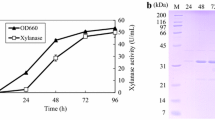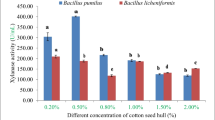Abstract
Xylose, the second most abundant sugar in lignocellulosic materials, is not efficiently utilized in current lignocellulose biotransformation processes, such as cellulosic ethanol production. The bioconversion of xylose to value-added products, such as pullulan, is an alternative strategy for efficient lignocellulose biotransformation. This paper reports the production of pullulan from xylose and hemicellulose hydrolysate by Aureobasidium pullulans AY82. The effects of DL-dithiothreitol (DTT) and pH on pullulan production from xylose were also intensively investigated. A maximal increase of 17.55% of pullulan production was observed in flasks added with 1.0 mM DTT. Batch fermentations with controlled pH were also conducted, and the optimal pH for cell growth and pullulan synthesis was 3.0 and 5.0, respectively. Based on these findings, two-stage pH control fermentations were performed, in which the pH of the medium was first adjusted to 3.0 for cell growth, and then changed to 5.0 for pullulan synthesis. However, the earlier the pH was changed to 5.0, the more pullulan was produced. Fermentation with controlled pH of 5.0 acquired the highest pullulan production. Under the optimized conditions (with the addition of 1.0 mM DTT and controlled pH of 5.0), the maximal pullulan production obtained from xylose was 17.63 g/L. A. pullulans AY82 also readily fermented hemicellulose hydrolysate under these optimized conditions, but with lower pullulan production (12.65 g/L). Fourier transform infrared spectroscopy and high-performance liquid chromatography showed that the structure of the pullulan obtained in this study was identical to that of the pullulan standard.
Similar content being viewed by others
References
Prakash, G., A. Varma, A. Prabhune, Y. Shouche, and M. Rao (2011) Microbial production of xylitol from d-xylose and sugarcane bagasse hemicellulose using newly isolated thermotolerant yeast Debaryomyces hansenii. Bioresour. Technol. 102: 3304–3308.
Chen, Y., B. Dong, W. Qin, and D. Xiao (2010) Xylose and cellulose fractionation from corncob with three different strategies and separate fermentation of them to bioethanol. Bioresour. Technol. 101: 6994–6999.
Sutherland, I. W. (1998) Novel and established applications of microbial polysaccharides. Trends. Biotechnol. 16: 41–46.
Cheng, K. -C., A. Demirci, and J. M. Catchmark (2011) Pullulan: Biosynthesis, production, and applications. Appl. Microbiol. Biotechnol. 92: 29–44.
Leathers, T. D. (2003) Bioconversions of maize residues to value — added coproducts using yeast — like fungi1. FEMS. Yeast Res. 3: 133–140.
Lazaridou, A., C. G. Biliaderis, T. Roukas, and M. Izydorczyk (2002) Production and characterization of pullulan from beet molasses using a nonpigmented strain of Aureobasidium pullulans in batch culture. Appl. Biochem. Biotechnol. 97: 1–22.
Wu, S., Z. Jin, Q. Tong, and H. Chen (2009) Sweet potato: A novel substrate for pullulan production by Aureobasidium pullulans. Carbohydr. Polym. 76: 645–649.
Leathers, T. (2003) Biotechnological production and applications of pullulan. Appl. Microbiol. Biotechnol. 62: 468–473.
Catley, B. (1971) Role of pH and nitrogen limitation in the elaboration of the extracellular polysaccharide pullulan by Pullularia pullulans. Appl. Microbiol. 22: 650–654.
Babu, B. K., H. Atiyeh, M. Wilkins, and R. Huhnke (2010) Effect of the reducing agent dithiothreitol on ethanol and acetic acid production by Clostridium strain P11 using simulated biomassbased syngas. Biol. Eng. 3: 19–35.
Panneerselvam, A., M. Wilkins, M. DeLorme, H. Atiyeh, and R. Huhnke (2009) Effects of various reducing agents on syngas fermentation by “Clostridium ragsdalei”. Biol. Eng. 2: 135–144.
Wang, X. -D., G. Mauvais, R. Cachon, C. Diviès, and G. Feron (2000) Addition of reducing agent dithiothreitol improves 4-decanolide synthesis by the genus Sporidiobolus. J. Biosci. Bioeng. 90: 338–340.
Maligie, M. A. and C. P. Selitrennikoff (2005) Cryptococcus neoformans resistance to echinocandins: (1, 3) β-glucan synthase activity is sensitive to echinocandins. Antimicrob. Agents. Chemother. 49: 2851–2856.
Miller, G. L. (1959) Use of dinitrosalicylic acid reagent for determination of reducing sugar. Anal. Chem. 31: 426–428.
Cheng, K. -C., A. Demirci, J. M. Catchmark, and V. M. Puri (2011) Effects of initial ammonium ion concentration on pullulan production by Aureobasidium pullulans and its modeling. J. Food. Eng. 103: 115–122.
Sutherland, I. (1982) Biosynthesis of microbial exopolysaccharides. Adv. Microb. Physiol. 23: 79–150.
McNeil, B. and B. Kristiansen (1990) Temperature effects on polysaccharide formation by Aureobasidium pullulans in stirred tanks. Enz. Microb. Technol. 12: 521–526.
Leathers, T., G. Nofsinger, C. Kurtzman, and R. Bothast (1988) Pullulan production by color variant strains of Aureobasidium pullulans. J. Ind. Microbiol. 3: 231–239.
Cheng, K. -C., A. Demirci, and J. M. Catchmark (2011) Evaluation of medium composition and fermentation parameters on pullulan production by Aureobasidium pullulans. Food. Sci. Technol. Int. 17: 99–109.
Pan, S., J. Chen, and S. Wu (2012) Influence of controlled pH on the activity of UDPG-pyrophosphorylase in Aureobasidium pullulans. Carbohydr. Polym. 92: 629–632.
Kuhn, L. P. (1950) Infrared spectra of carbohydrates. Anal. Chem. 22: 276–283.
Singh, R. S., G. K. Saini, and J. F. Kennedy (2009) Downstream processing and characterization of pullulan from a novel colour variant strain of Aureobasidium pullulans FB-1. Carbohydr. Polym. 78: 89–94.
Author information
Authors and Affiliations
Corresponding author
Rights and permissions
About this article
Cite this article
Chen, Y., Guo, J., Li, F. et al. Production of pullulan from xylose and hemicellulose hydrolysate by Aureobasidium pullulans AY82 with pH control and DL-dithiothreitol addition. Biotechnol Bioproc E 19, 282–288 (2014). https://doi.org/10.1007/s12257-013-0715-4
Received:
Revised:
Accepted:
Published:
Issue Date:
DOI: https://doi.org/10.1007/s12257-013-0715-4




